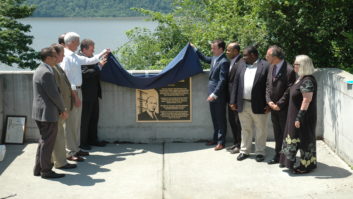
A vintage radio (with modern external speaker) is tuned to the WA2XMN test transmission before the event starts.
When the inventor of FM radio stepped out a New York City window to his death 60 years ago this winter, he was despondent about the fate of his invention amidst a pitched legal battle with the giant Radio Corporation of America.
We can’t get inside the Major’s mind on that frosty Upper East Side night, but it’s easy to imagine that he believed his work developing FM would fade into technological obscurity.
What would Maj. Edwin Howard Armstrong have made, then, of the crowd that gathered last summer to dedicate a plaque in his honor at one of the spots where he was happiest, his native Yonkers, N.Y.?
Armstrong was born in 1890 in a huge Victorian home just across Warburton Avenue from the site of the bronze plaque in Hudson-Fulton Park. Much of his early work in radio, including the development of the superheterodyne system in the early years of the 20th century, took place in the attic of the Warburton Avenue home. And after Armstrong’s feud with RCA chairman David Sarnoff pushed his early FM experiments out of RCA’s space in the Empire State Building, the Major looked just across the Hudson River from Yonkers to build his unique three-armed tower in Alpine, N.J., in 1937–38, easily visible then and now from Warburton Avenue (shown below).

Unveiling the memorial plaque. Armstrong relatives remained in the home on Warburton for decades after the Major’s death, but the property was sold in the 1980s. The house eventually was razed and replaced with a blocky apartment building, leaving nothing at the site to tell visitors the story of the remarkable man who’d once lived and invented there.
Enter Steve Klose, a New Jersey resident who knew little about radio history but learned of Armstrong because of their shared interest in fast motorcycles.
Klose became fascinated by Armstrong’s story and increasingly convinced that his legacy needed to be remembered with a plaque on Warburton Avenue. Beginning in 2012, Klose led a fundraising campaign that generated more than $4,000 in contributions to pay for the plaque. Working with Yonkers officials, he considered several sites for the plaque, eventually moving from the actual site of Armstrong’s home across the street to the park, where a viewing platform extends from the edge of the steep cliff overlooking the river.
With a picture-perfect view down to the Hudson and across to the Alpine tower, the wall of the viewing platform proved to be an ideal spot for the memorial.

Steve Klose, who conceived of the plaque and oversaw fundraising and installation, celebrates at completion of the project. Yonkers mayor Mike Spano and several city councilors were on hand for the dedication ceremony, joined by two Armstrong descendants. The ceremony even had a live broadcast, though few contemporary listeners could hear it. The line-of-sight across the river made for an easy Marti shot to the Alpine tower, where the ceremony was simulcast on WA2XMN. That’s the experimental “Armstrong memorial station” that transmits on Armstrong’s old 42.8 MHz frequency from the tower in Alpine using a replica Phasitron transmitter lovingly hand-built by Pennsylvania engineer Steve Hemphill, who hosted the live coverage from a corner of the park.
“He changed the world with his inventions, and it all began right here,” said Armstrong relative Adam Brecht, who read a letter from Jeanne Hammond, Armstrong’s great-niece and, at 92, the inventor’s oldest living relative. Her letter shared stories of Armstrong’s family side, recounting the tight bonds among family members who lived in a cluster of adjoining homes on Warburton Avenue and the neighboring streets that climb steeply uphill toward downtown Yonkers.
After the half-hour ceremony on a warm, sunny afternoon, guests were treated to a cake displaying an image of Armstrong.
With the 2018 centennial of Armstrong’s superheterodyne patent approaching, the plaque may not be the last commemoration of Armstrong in his native Yonkers. City officials are working to get a replica made of a bust of Armstrong now on display at Columbia University, and there’s talk of renaming part of Warburton Avenue in the Major’s honor.
Scott Fybush is a longtime contributor.












